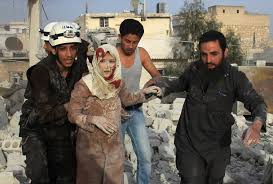Aid Agencies on Wednesday said buses carrying evacuees started leaving the last rebel-held enclave of Syria’s Aleppo again, raising hopes that a last minute hold-up had been resolved.
Civilians had been waiting in freezing temperatures since plans to get them out of the war-battered city hit problems on Tuesday.
Sixty buses were stuck there, a war monitor said earlier on as TV pictures showed vehicles covered in snow.
However, a UN official in Syria told newsmen by email at 1400 GMT that buses had started moving again from east Aleppo.
“We hope that this continues so that people can be safely evacuated,’’ the official added.
Government forces agreed the evacuations as part of a deal also included the evacuation of people from Shi’ite Muslim villages besieged by rebels in Idlib.
The Syrian Observatory for Human Rights war monitor said eight buses en route to Aleppo from those villages of al-Foua and Kefraya had also been held up since Tuesday.
UN spokesman Jensen Clarke said in Geneva that more UN staff had arrived in east Aleppo to help monitor the evacuation in line with a resolution unanimously adopted by the UN Security Council on Monday.
Syrian TV said that four buses and two ambulances arrived in government-controlled Aleppo from al-Foua and Kefraya in Idlib, while 15 buses containing fighters and their families had started to leave East Aleppo.
The International Committee of the Red Cross (ICRC), which is running the operation with the Syrian Arab Red Crescent (SARC), confirmed that the evacuation had resumed.
ICRC Spokeswoman Kris Armstrong told newsmen in Geneva that weather conditions were harsh and people exhausted.
“All patients have been evacuated, al-Quds hospital (the only remaining hospital in the enclave), is now empty, and all other urgent medical cases have now been evacuated,’’ Armstrong said.
Footage which Syrian state television said was of the buses waiting to leave Aleppo, showed falling snow and snow-covered ground around the buses. (Reuters/NAN)


